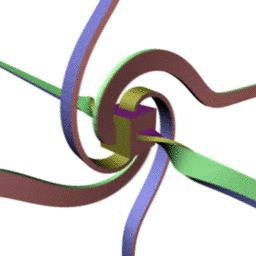 | ||
In mathematics and physics, the plate trick, also known as Dirac's string trick, the belt trick, Balinese cup trick, is any of several demonstrations of the mathematical theorem that SU(2) (which double-covers SO(3)) is simply connected. To say that SU(2) double-covers SO(3) essentially means that the unit quaternions represent the group of rotations twice over. In simple terms, rotating an object with strings attached by 360 degrees does not return the system to its original state, while a second rotation of 360 degrees, a total rotation of 720 degrees, does.
Contents
The trick
One way of doing the trick is to rest a small plate flat on the palm, then perform two rotations of one's hand while keeping the plate upright, ending in the original position. The hand makes one rotation passing over its shoulder, twisting the arm, and then another rotation passing under, untwisting it.
Supposedly there is a Balinese candle dance, where an open cup of liquid is held instead of a plate. Since the feet can remain fixed during the manoeuvre, but the hand rotates twice, and all the arm and shoulder and other body segments smoothly connect the feet to the hand and undergo the intermediate rotations, then the rotation loops that each segment undergoes are progressively collapsed as one progresses from the hand along the arm to the shoulder, torso, legs and finally the feet, which represent the collapse of the loop to a point, since they did not rotate. Similarly, for the belt version of the trick, the buckle rotates twice, but the opposite end of the belt remains fixed, and all along the rest of the belt are the progressively collapsing rotation loops from buckle to fixed end.
Figure-eight twirling used in baton twirling, staff twirling in martial arts, and swordsmanship, provides a similar demonstration. Here it is also fairly easy and natural to collapse the motion of the hand progressively down through a wiggle to a stationary position, providing an additional, and perhaps more intuitive demonstration that the double rotation loop can be collapsed to a point.
In mathematical physics, the trick illustrates the mathematics behind certain aspects of spin 1/2 particles, or fermions. Very loosely speaking, as with the plate such a particle in relation to its surroundings returns to its original state only after two full rotations, not after one.
In fiction
A fictional extension of the belt trick appears in Ian McEwan's novel Solar as a plot device to explain the protagonist's Nobel prize work.
